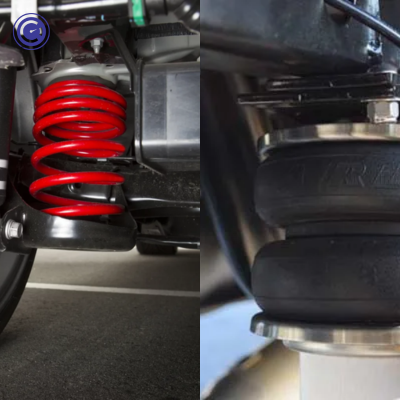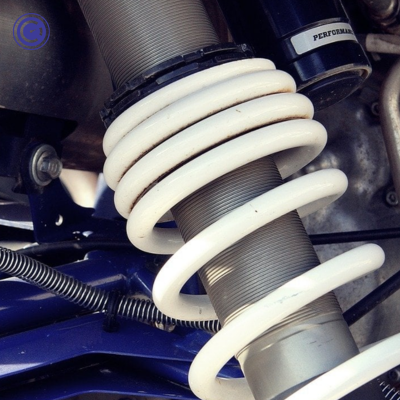Understanding your car’s suspension system is crucial for ensuring both safety and comfort while driving. The suspension system is a key component in vehicle maintenance and handling. This blog post aims to explore the ins and outs of car suspensions, guiding car owners and future buyers through its complexities.
Table of Contents
What is Car Suspension?

In the realm of automotive engineering, the suspension system of a car is one of its most crucial components, playing a vital role in ensuring both safety and comfort for passengers. Understanding what car suspension is and its functions is essential for any car owner or future buyer.
Defining Car Suspension

Car suspension refers to the system of springs, shock absorbers, struts, control arms, and other components that connect a vehicle to its wheels. This system serves several critical functions:
- Absorbing Shock: As a vehicle moves over uneven surfaces, the suspension system absorbs the shocks from the road, ensuring that the ride remains smooth and stable.
- Supporting Weight: The suspension system bears the weight of the vehicle, providing support and stability under varying load conditions.
- Maintaining Road Contact: It helps maintain consistent contact between the tires and the road, which is essential for safe steering, braking, and overall stability.
Components of a Typical Car Suspension System
A car’s suspension system is made up of various parts, each contributing to the vehicle’s handling and ride quality:
- Springs: These are typically coil springs, leaf springs, or air springs, and they absorb and release energy when the car moves over bumps.
- Shock Absorbers and Struts: These components dampen the motion of the springs and prevent the car from bouncing excessively.
- Control Arms: These connect the suspension to the vehicle’s frame and allow for motion while steering.
- Sway Bars: Also known as anti-roll bars, these prevent the car from rolling excessively in corners and keep the vehicle stable.
Function in the Emission Control System
The suspension system is a key part of a car’s overall design and contributes significantly to the emission control system by ensuring stable and efficient driving, which can impact the vehicle’s emissions and fuel efficiency.
Types of Car Suspension Systems
There are various types of suspension systems used in cars:
- Independent Suspension: Each wheel has its own independent suspension system, allowing for better handling and comfort.
- Semi-independent Suspension: Offers a balance between a fully independent system and a rigid axle, common in smaller cars.
- Solid Axle Suspension: A more traditional form where the wheel on one side is directly affected by the movement of the wheel on the other side.
How Does Car Suspension Work?

Understanding how car suspension works is essential for appreciating the complex engineering that goes into making your driving experience both comfortable and safe. The suspension system in a car is designed to maximize friction between the tires and the road surface, provide steering stability, and ensure passenger comfort. Let’s dive into the mechanics of how car suspension fulfills these critical roles.
The Basics of Suspension Mechanics
The primary function of the suspension system is to absorb the shocks and bumps from the road and to maintain tire contact with the road. Here’s how it accomplishes this:
Absorbing Road Shock
- Springs: When a car encounters a bump or a dip, it’s the springs, whether coil springs, leaf springs, or torsion bars, that absorb the initial shock. They compress and expand to absorb the vertical energy created by road irregularities.
Dampening Spring Motion
- Shock Absorbers and Struts: After a spring absorbs a shock, it naturally oscillates. Shock absorbers, or in some cases struts, dampen this motion, controlling unwanted spring movement. They ensure that the tires remain in contact with the road, improving grip and handling.
Maintaining Wheel Alignment
- Control Arms, Rods, Bars, and Joints: These components keep the wheels aligned with each other and with the vehicle. Proper alignment is critical for maintaining steering stability and tire longevity.
Types of Suspension Systems
Car suspensions come in various designs, each with unique characteristics:

- Independent Suspension: Each wheel has its own suspension system. This setup allows for more precise handling and a smoother ride because the movement of one wheel doesn’t directly affect the others.
- Semi-independent Suspension: This system offers a compromise, allowing some independent movement between wheels, commonly used in smaller, lighter cars.
- Air Suspension: Uses air springs instead of traditional coils, offering a very smooth ride that can be adjusted for different conditions or loads.
Types of Suspension in Cars
Car suspension systems come in various types, each designed to meet specific driving needs and provide a unique balance between comfort and control. Understanding these different types of suspension systems can help you appreciate how your vehicle handles the road and responds to various driving conditions. Let’s explore the most common types of car suspensions.
Independent Suspension
Definition and Function
- Individual Wheel Movement: In an independent suspension system, each wheel on the same axle moves independently of the other. This means that movement on one side does not directly affect the other side.
- Benefits: Offers superior ride comfort and handling. It’s particularly effective in smoothing out road irregularities and maintaining tire contact with the road.
Common Types
- MacPherson Strut: Widely used in front-wheel-drive cars. It combines a shock absorber and a coil spring into a single unit.
- Double Wishbone: Features two arms (wishbones) and allows for more precise wheel control, commonly used in sports cars.
Semi-Independent Suspension
Overview
- Limited Independent Movement: This suspension allows for some independent movement between the wheels on the same axle but is not entirely separate like in the independent system.
- Example: The twist beam rear suspension, often found in small to medium front-wheel-drive cars, is a common form of semi-independent suspension.
Rigid Axle Suspension
Characteristics
- Solid Construction: Both wheels on the axle are connected, meaning they move together. This type of suspension is more often seen in older models and heavy-duty vehicles.
- Types: Includes solid axle (both wheels fixed to a solid beam or shaft) and live axle (the axle moves with the wheels).
Air Suspension
Description
- Air Springs: Instead of traditional metal springs, air suspension systems use air springs. The air pressure can be adjusted, either manually or automatically, to suit different loads and conditions.
- Advantages: Provides a very smooth ride and is adjustable for different situations. It’s commonly found in luxury vehicles and buses.
Multi-Link Suspension
Details
- Complex Design: Consists of several arms (links) that allow for a high level of control over the wheel motion.
- Usage: Often used in modern vehicles, especially at the rear, to provide a good balance of handling and comfort.
Adaptive and Active Suspension
Cutting-Edge Technology
- Electronically Controlled: These systems can adjust the suspension characteristics automatically in real-time, based on driving conditions.
- Dynamic Handling: Ideal for enhancing performance, comfort, and safety. They are increasingly common in high-end and performance vehicles.
Signs of a Bad Suspension System
The suspension system in your car is crucial for ensuring a smooth, safe ride. Over time, however, it can wear out or become damaged, leading to a range of issues. Being aware of the signs of a bad suspension system is important for maintaining your vehicle’s safety and performance. Here are key indicators that your car’s suspension system may need attention:
Uneven Tire Wear
- Irregular Patterns: If you notice that your tires are wearing down unevenly or more quickly than usual, it could be a sign that your suspension is not holding the car evenly, thereby putting uneven pressure on the tires.
- Alignment Issues: Uneven tire wear can also indicate alignment problems, often related to suspension faults.
Poor Handling or Excessive Bouncing
- Handling Difficulties: If your car isn’t handling as well as it used to, such as experiencing difficulty when turning or a noticeable drift or pull, the suspension could be to blame.
- Bouncing Test: After going over bumps or potholes, if your car continues to bounce or feels unusually bouncy, it suggests the shock absorbers might be worn out.
Noises When Driving Over Bumps
- Strange Sounds: Clunking, rattling, or knocking sounds when you drive over bumps or potholes are telltale signs of suspension problems. These noises often point to worn or damaged suspension components.
Car Sits Low or Leans
- Sagging Corner: If one corner of your car sits lower than the others when parked, it’s a sign that a spring has broken or is wearing out.
- Leaning During Turns: If your car leans or “dips” more than usual during turns or when braking, it can indicate issues with the shocks or struts.
Feeling Every Bump
- Rough Ride: One of the most common signs of a failing suspension system is feeling every bump in the road, or the ride becoming generally less comfortable. This usually means the shocks or struts are worn out.
Fluid Leaks from Shocks or Struts
- Visible Leaks: Check your shocks or struts for leaks. If you see oily, greasy residue on or around the shock absorbers or struts, it could mean they are leaking fluid and are no longer functioning properly.
The Importance of Suspension Maintenance
Maintaining your car’s suspension system is not just about ensuring a smooth ride; it’s a critical aspect of vehicle safety and longevity. The suspension system, comprising components like springs, shock absorbers, struts, control arms, and sway bars, plays a crucial role in handling and comfort. Regular maintenance of these components is essential for several reasons.
Ensuring Vehicle Safety
- Stability and Handling: A well-maintained suspension system provides better handling of the vehicle. It ensures that the car remains stable at high speeds and during cornering.
- Braking Efficiency: The suspension system affects the car’s braking. A poorly maintained suspension can increase stopping distances.
Enhancing Ride Comfort
- Absorbing Bumps: One of the main functions of the suspension system is to absorb bumps on the road, providing a smoother ride. Worn suspension parts can lead to a bumpy, uncomfortable driving experience.
- Reducing Car Body Roll: Good suspension maintenance helps in minimizing the roll or sway of the car body while turning, enhancing passenger comfort.
Prolonging Vehicle Life
- Preventing Component Wear: Regular suspension maintenance can prevent excessive wear on other vehicle components, including tires and brakes.
- Avoiding Major Repairs: Catching and addressing minor suspension issues early through routine maintenance can help avoid more significant, costly repairs in the future.
Optimizing Fuel Efficiency
- Alignment and Efficiency: A well-maintained suspension system helps keep the vehicle properly aligned, which can improve fuel efficiency. Poor alignment, a symptom of suspension issues, can lead to increased resistance on the road.
Maintaining Resale Value
- Vehicle Condition: Regular maintenance, including the suspension system, can help maintain the vehicle’s condition and thus its resale value.
Regular Suspension Checks
- Visual Inspections: Regularly inspect for signs of wear or damage, such as leaks from shocks or struts, and worn or broken springs.
- Professional Inspections: Have a professional mechanic check the suspension system regularly, especially if you notice any signs of problems.
Diagnosing Suspension Issues
Suspension issues can significantly affect the performance and safety of your vehicle. Diagnosing these problems early is crucial for maintaining the integrity of your car and ensuring a comfortable driving experience. Here’s a step-by-step guide on how to identify common suspension issues:
Visual Inspection
Start with a simple visual check to identify any obvious signs of suspension problems:
- Check for Uneven Tire Wear: Uneven wear on your tires can indicate misalignment, often caused by suspension issues.
- Look for Damaged Suspension Components: Visually inspect for any visible damage to springs, shock absorbers, struts, and control arms. Look for signs of rust, leaks, or physical damage.
Bounce Test
The bounce test can help you assess the condition of your shock absorbers and struts:
- Press Down on Each Corner of the Car: Apply pressure to each corner of your vehicle and then release.
- Observe the Bounce: If the car bounces up and down more than twice after releasing it, this could indicate worn shock absorbers or struts.
Listen for Noises
Pay attention to the sounds your car makes, especially when driving over bumps or potholes:
- Listen for Clunks and Squeaks: Noises like clunking, rattling, or squeaking from the car’s undercarriage during driving can indicate suspension problems.
Assess the Ride Quality
Your driving experience can tell you a lot about the state of your suspension:
- Feel for Excessive Bouncing or Swerving: If the car feels unstable, sways excessively during turns, or continues to bounce after going over bumps, these are signs of suspension problems.
Pay Attention to Steering
Suspension issues can affect steering:
- Difficulty Steering: If steering becomes difficult, especially at low speeds, it might be related to suspension issues.
- Car Pulling to One Side: If the car tends to pull to one side, it could be an alignment issue stemming from the suspension.
Use Diagnostic Tools
For a more thorough diagnosis, you may need special tools:
- OBD-II Scanner: Modern cars equipped with an OBD-II port can be scanned for diagnostic trouble codes that might point to suspension issues.
Consult a Professional
If you have identified potential problems or if you’re unsure, it’s always best to consult with a professional mechanic:
- Professional Inspection: A skilled mechanic can perform a detailed inspection, using specialized tools and their expertise to diagnose suspension issues accurately.
- Expert Opinion: They can also provide you with advice on the necessary repairs or replacements.
Preventative Measures and Maintenance Tips
To maintain a healthy suspension:
- Regular Checks: Include suspension in your regular vehicle check-ups.
- Avoid Harsh Conditions: Try to avoid potholes and rough roads where possible.
- Component Care: Regularly inspect and maintain critical parts like shocks, struts, and springs.
Professional Assistance and Repairs
For complex suspension issues or if you’re unsure about a problem, seeking professional help is advisable. Suspension systems can be intricate, and expert evaluation ensures accurate diagnosis and repair.
Conclusion
Your car’s suspension system is a critical component for a safe and comfortable driving experience. Regular maintenance and attention to potential issues can keep your vehicle running smoothly and extend its lifespan.

